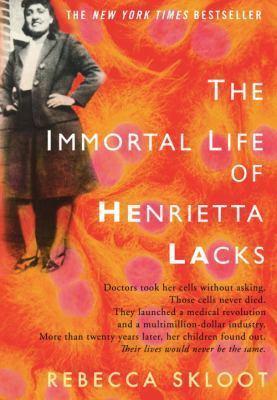
I’d venture a guess that everyone in this world has, at some point in their life, gone through some kind of medical testing, or at the very least had blood drawn for routine blood tests. If you’re like me, you probably never gave a second thought as to what happened to that blood (or tissues) that were removed from your body for those tests. You’ve even signed papers related to those fluids and tissues – and let’s be honest – you probably didn’t really read that paperwork super thoroughly …
So what does happen with that stuff once the scientists in the labs have done their thing? Well, that’s an interesting question and brings up a lot of interesting discussion. Today, we do all sign paperwork giving the medical community the rights to those tissues/fluids, but that wasn’t always the case, and that’s where the story of Henrietta Lacks come in.
Henrietta was a “colored woman” (this is how she is referred to in the book) born in Roanoke, Virginia in 1920, but after marrying David Lacks (her first cousin), she moved to Baltimore, Maryland. When she was 31, after having her 5th child, she knew something wasn’t right and had her husband take her to Johns Hopkins Hospital. In the course of trying to determine what was wrong with Henrietta, a biopsy of a tumor on her cervix was taken, and from these tissues, scientists, for the first ever, were able to grow human cells in the lab. These cells, called HeLa (for HEnreitta LAcks) are still alive and growing today, and have helped scientists all over the world make many incredible discoveries and led to much advancement in medical science. The way those cells were obtained and subsequently shared around the world though is what this book talks about.
You see, no one told Henrietta what they were doing, and no one asked for her permission to keep, use and distribute those cells, and even after her death -- because there was indeed something wrong, and she died 10 months after her first visit to Johns Hopkins – when her husband was asked to sign a paper allowing the hospital to do an autopsy, things weren’t necessarily explained in a way David, who only had a 4th grade education, could understand. It wasn’t until twenty years later that her family found out that her cells were still living and being used by science. They had no idea, had never been asked permission, and had received no compensation.
This book tells the story of the family finding out about these cells and trying to come to an understanding of what that really means, explores the ethics behind cell culture and the history of cell usage for medical research, and touches on the question of whether or not those cells still belong to us after they have been removed from our bodies.
Overall, I enjoyed this book. There were times when the science speak came close to losing me, but most of the time I could understand what was being said and most of the book reads like a novel. If you are looking for a nonfiction read – this is one I would recommend!